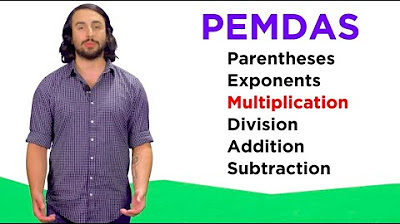Math Antics - Order Of Operations
TLDRIn this Math Antics video, the concept of Order of Operations is explained. The video clarifies why mathematical rules are necessary for consistent results, demonstrating with the problem 2 + 5 × 4. It introduces the four rules: 1) Perform operations inside parentheses or brackets first, 2) Handle exponents next, 3) Carry out multiplication and division from left to right, and 4) Complete addition and subtraction from left to right. Examples illustrate each rule, emphasizing the importance of order to avoid confusion and ensure correct answers. Learn more at www.mathantics.com.
Takeaways
- 📚 The Order of Operations is a set of rules that dictate the sequence in which mathematical operations should be performed.
- 🤔 The necessity for Order of Operations arises because performing operations in different orders can lead to different results, which is not ideal in mathematics.
- 👥 The video demonstrates the concept using a scenario where two people solve the same problem (2 + 5 × 4) but get different answers due to the order in which they perform the operations.
- 🔢 The Order of Operations acronym is often remembered as PEMDAS, which stands for Parentheses, Exponents, Multiplication and Division (from left to right), and Addition and Subtraction (from left to right).
- 👉 The first rule is to perform operations inside Parentheses and Brackets first, as they group expressions together and indicate priority.
- 📐 If a problem has multiple sets of parentheses, simplify each set before performing any operations outside of them.
- 💪 The second rule is to address Exponents next, which represent repeated multiplication and are simplified before other operations.
- 🔄 The third and fourth rules prioritize Multiplication and Division over Addition and Subtraction, and operations should be performed from left to right when there is a tie in priority.
- 📉 An example of a problem with a mixture of operations is 40 ÷ 4 × 5, which illustrates the importance of following the left-to-right rule to avoid incorrect results.
- 📈 The video emphasizes the importance of following the Order of Operations to ensure everyone gets the same answer to a given mathematical problem, maintaining consistency and clarity in math.
Q & A
What is the main topic discussed in the Math Antics video?
-The main topic discussed in the Math Antics video is the Order of Operations, which is a set of math rules that dictate the sequence in which mathematical operations should be performed.
Why are rules needed for Order of Operations?
-Rules for Order of Operations are needed to ensure that everyone gets the same answer when solving a given math problem, preventing confusion and inconsistency in mathematical calculations.
What is the first rule of Order of Operations?
-The first rule of Order of Operations is to perform operations inside parentheses and brackets first.
Can you explain how parentheses and brackets function in math?
-Parentheses and brackets are used to group numbers and operations together, indicating that the operations within them should be performed before those outside. They function similarly but have different shapes; parentheses are more curved while brackets are boxier.
What is the correct answer to the problem 2 + 5 × 4, according to the Order of Operations?
-According to the Order of Operations, the correct answer to the problem 2 + 5 × 4 is 22, because multiplication should be done before addition.
What is the second rule in the Order of Operations?
-The second rule in the Order of Operations is to perform exponents after taking care of any operations inside parentheses or brackets.
What does the term 'exponent' represent in math?
-In math, an 'exponent' represents the number of times a base number is multiplied by itself. For example, in 4^3, the base number 4 is multiplied by itself 3 times.
How do you handle exponents inside parentheses?
-You handle exponents inside parentheses by performing the exponent operation first, as this is considered part of the operation inside the parentheses, adhering to the Order of Operations rules.
What are the last two rules of Order of Operations?
-The last two rules of Order of Operations are to perform multiplication and division before addition and subtraction, and to always work from left to right when dealing with operations of equal priority.
Can you give an example of how the 'from left to right' rule applies?
-An example of the 'from left to right' rule is in the problem 40 ÷ 4 × 5. You should first divide 40 by 4 to get 10, and then multiply the result by 5 to get 50, not the other way around.
What is the purpose of the Order of Operations rules?
-The purpose of the Order of Operations rules is to provide a standardized approach to solving mathematical problems, ensuring that everyone arrives at the same answer when following the same sequence of operations.
How does the video demonstrate the importance of following Order of Operations?
-The video demonstrates the importance of following Order of Operations by showing two different people solving the same problem (2 + 5 × 4) but getting different answers due to performing operations in a different order, highlighting the need for standardized rules.
Outlines
📚 Introduction to Order of Operations
This paragraph introduces the concept of Order of Operations, explaining its necessity in mathematics to ensure consistency in solving problems. It begins with a hypothetical scenario where two individuals solve the same problem, 2 + 5 × 4, but in different orders, leading to different answers. This illustrates the need for a standardized approach to performing mathematical operations. The paragraph then outlines the four fundamental rules of Order of Operations: solving operations within parentheses and brackets first, followed by exponents, then multiplication and division (from left to right), and finally addition and subtraction (also from left to right). The explanation includes a brief description of how parentheses and brackets function to group operations, emphasizing the importance of following these rules to achieve uniform results in mathematics.
🔢 Detailed Explanation of Order of Operations Rules
The second paragraph delves deeper into the Order of Operations rules, providing clarity and examples for each. It starts by discussing the handling of parentheses and brackets, illustrating how they group expressions that must be computed first. The paragraph then moves on to exponents, explaining them as a shorthand for repeated multiplication and emphasizing their priority after parentheses. The next section focuses on the precedence of multiplication and division over addition and subtraction, using examples to demonstrate how these operations should be performed from left to right. The paragraph concludes with a recap of the Order of Operations rules, reinforcing their importance for solving mathematical problems accurately and consistently. Additionally, it addresses a common misconception about the order of operations with exponents and provides a final example that highlights the significance of following the rules from left to right to avoid incorrect results.
Mindmap
Keywords
💡Order of Operations
💡Parentheses
💡Brackets
💡Exponents
💡Multiplication
💡Division
💡Addition
💡Subtraction
💡Left to Right
💡Calculus
💡Consistency
Highlights
Order of Operations is a set of rules that dictate the sequence of mathematical operations.
Without rules, different people could solve the same problem and get different answers.
The problem 2 + 5 × 4 demonstrates the importance of Order of Operations.
Two individuals solving the same problem can get different answers by changing the order of operations.
The Order of Operations ensures everyone gets the same answer when solving a problem.
The four main rules of Order of Operations are explained in the video.
First rule: Always perform operations inside parentheses and brackets first.
Parentheses and brackets group numbers and operators together, indicating priority.
Example problem 10 × (4 + 5) illustrates the process of solving within parentheses first.
If a problem has multiple sets of parentheses, simplify each set before proceeding.
Second rule: After parentheses, simplify any exponents.
Exponents represent repeated multiplication and have a higher priority than basic operations.
Problems with exponents inside parentheses should be simplified starting with the exponent.
Third and fourth rules: Perform multiplication and division before addition and subtraction.
Multiplication and division are of equal priority, as are addition and subtraction.
Operations of equal priority should be performed from left to right.
Example problems demonstrate the correct sequence of operations according to the rules.
The video concludes with a reiteration of the Order of Operations rules for clarity.
The video provides exercises to help viewers practice the Order of Operations.
For more information and resources, visit www.mathantics.com.
Transcripts
Browse More Related Video

How To Evaluate Expressions With Variables Using Order of Operations

a very simple algebra question , but 97% FAILED

Order of Arithmetic Operations: PEMDAS

Math Antics - Adding and Subtracting Fractions

Algebra Basics: Solving 2-Step Equations - Math Antics

Rounding and Order of Operations Used in Significant Figures
5.0 / 5 (0 votes)
Thanks for rating: